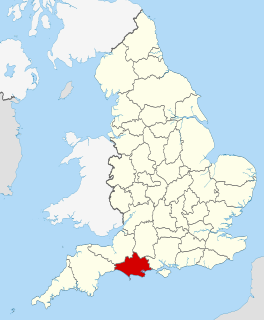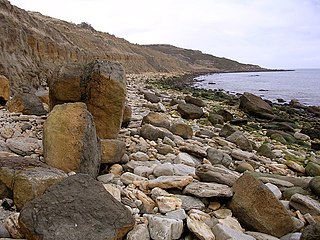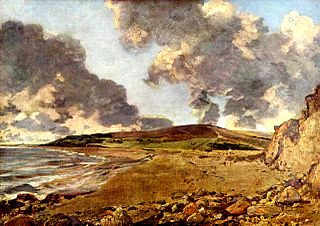


Redcliff Point is on the south coast of England, to the east of Weymouth in Dorset. It lies just past the eastern end of the sweeping Weymouth Bay on the Jurassic Coast, a UNESCO World Heritage landscape known for its geology. [1] Fossils can be found in the Upper Oxford Clay in this area. [2]

England is a country that is part of the United Kingdom. It shares land borders with Wales to the west and Scotland to the north-northwest. The Irish Sea lies west of England and the Celtic Sea lies to the southwest. England is separated from continental Europe by the North Sea to the east and the English Channel to the south. The country covers five-eighths of the island of Great Britain, which lies in the North Atlantic, and includes over 100 smaller islands, such as the Isles of Scilly and the Isle of Wight.

Weymouth is a seaside town in Dorset, England, situated on a sheltered bay at the mouth of the River Wey on the English Channel coast. The town is 11 kilometres (7 mi) south of Dorchester and 8 kilometres (5 mi) north of the Isle of Portland. The town's population is 52,323 (2011). Weymouth has a metropolitan population of 71,083 (2016). The town is the third largest settlement in Dorset after Bournemouth and Poole.

Dorset is a county in South West England on the English Channel coast. The ceremonial county comprises the unitary authority areas of Bournemouth, Christchurch and Poole and Dorset. Covering an area of 2,653 square kilometres (1,024 sq mi), Dorset borders Devon to the west, Somerset to the north-west, Wiltshire to the north-east, and Hampshire to the east. The county town is Dorchester which is in the south. After the reorganisation of local government in 1974 the county's border was extended eastward to incorporate the Hampshire towns of Bournemouth and Christchurch. Around half of the population lives in the South East Dorset conurbation, while the rest of the county is largely rural with a low population density.
The cliff looks over to the Isle of Portland. It is so-called because of the red colouring of the cliffs at this point. [3]

The Isle of Portland is a limestone tied island, 4 miles (6 km) long by 1.7 miles (2.7 km) wide, in the English Channel. Portland is 5 miles (8 km) south of the resort of Weymouth, forming the southernmost point of the county of Dorset, England. A barrier beach called Chesil Beach joins it to the mainland. The A354 road passes down the Portland end of the beach and then over the Fleet Lagoon by bridge to the mainland. Portland and Weymouth together form the borough of Weymouth and Portland. The population of Portland is 12,400.
Close by to the west are the Broadrock cliffs and Bowleaze Cove. To the east are Black Head and the coastal village of Osmington Mills.

Broadrock is a cliff on the coast in Dorset, southern England. It faces out into Weymouth Bay between Bowleaze Cove and Redcliff Point. There are many landslips on the cliffs at this point.

Bowleaze Cove is a small sand and shingle beach, near the village of Preston, just to the northeast of Weymouth, Dorset, England. The cove is on the Jurassic Coast and is known for its geology. Just to the west is Furzy Cliff.

Black Head a headland on the south coast of England, to the east of Weymouth in Dorset. It lies on the Jurassic Coast, a UNESCO World Heritage landscape known for its geology. Fossils can be found in the area.
















